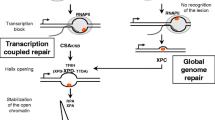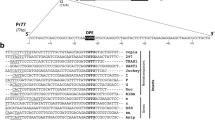Abstract
The long 5′-untranslated region (5′-UTR) of the human L1 retrotransposon contains a unique internal promoter, allowing new L1 copies to be less dependent on the integration site at the transcriptional level. The mechanism of action of this promoter still remains unclear; however, some early studies have build up an opinion that the first 5′-UTR segment of 100–150 nt (known as the minimal promoter) is most crucial for the functioning of the full-length promoter. This study shows that the activity of the minimal promoter is rather low in comparison with the activity of the full-length 5′-UTR. Instead, 5′-UTR internal segment 390–662, containing numerous binding sites for various transcription factors, is indispensable for effective L1 transcription and can be considered as a transcriptional enhancer. Deletion of this segment dramatically reduces the level of transcription irrespective of the cell type, whereas deletion of the first 100 nt decreases the transcription level only by a factor of 1.5–2. Thus, the L1 regulatory region remains to be structurally similar to that of well-studied invertebrate LINEs. It is also possible that the internal 5′-UTR segment of L1 contains an alternative promoter, driving synthesis of a 5′-truncated L1 mRNA.
Similar content being viewed by others
References
Ostertag E.M., Kazazian H.H., Jr. 2001. Biology of mammalian L1 retrotransposons. Annu. Rev. Genet. 35, 501–538.
Swergold G.D. 1990. Identification, characterization, and cell specificity of a human LINE-1 promoter. Mol. Cell. Biol. 10, 6718–6729.
Minakami R., Kurose K., Etoh K., Furuhata Y., Hattori M., Sakaki Y. 1992. Identification of an internal cis-element essential for the human L1 transcription and a nuclear factor(s) binding to the element. Nucleic Acids Res. 20, 3139–3145.
Becker K.G., Swergold G.D., Ozato K., Thayer R.E. 1993. Binding of the ubiquitous nuclear transcription factor YY1 to a cis regulatory sequence in the human LINE-1 transposable element. Hum. Mol. Genet. 2, 1697–1702.
Mathias S.L., Scott A.F. 1993. Promoter binding proteins of an active human L1 retrotransposon. Biochem. Biophys. Res. Commun. 191, 625–632.
Yang N., Zhang L., Zhang Y., Kazazian H.H., Jr. 2003. An important role for RUNX3 in human L1 transcription and retrotransposition. Nucleic Acids Res. 31, 4929–4940.
Tchenio T., Casella J.F., Heidmann T. 2000. Members of the SRY family regulate the human LINE retrotransposons. Nucleic Acids Res. 28, 411–415.
Speek M. 2001. Antisense promoter of human L1 retrotransposon drives transcription of adjacent cellular genes. Mol. Cell. Biol. 21, 1973–1985.
Muotri A.R., Chu V.T., Marchetto M.C., Deng W., Moran J.V., Gage F.H. 2005. Somatic mosaicism in neuronal precursor cells mediated by L1 retrotransposition. Nature. 435, 903–910.
Steinhoff C., Schulz W.A. 2003. Transcriptional regulation of the human LINE-1 retrotransposon L1.2B. Mol. Genet. Genomics. 270, 394–402.
Athanikar J.N., Badge R.M., Moran J.V. 2004. A YY1-binding site is required for accurate human LINE-1 transcription initiation. Nucleic Acids Res. 32, 3846–3855.
Wade D.P., Puckey L.H., Knight B.L., Acquati F., Mihalich A., Taramelli R. 1997. Characterization of multiple enhancer regions upstream of the apolipoprotein(a) gene. J. Biol. Chem. 272, 30,387–30,399.
Yang Z., Boffelli D., Boonmark N., Schwartz K., Lawn R. 1998. Apolipoprotein(a) gene enhancer resides within a LINE element. J. Biol. Chem. 273, 891–897.
Stoneley M., Paulin F.E., Le Quesne J.P., Chappell S.A., Willis A.E. 1998. c-Myc 5′-untranslated region contains an internal ribosome entry segment. Oncogene. 16, 423–428.
Sambrook J., Russell D. 2001. Molecular Cloning: A Laboratory Manual. 3d ed. Cold Spring Harbor, NY: Cold Spring Harbor Lab. Press.
Skowronski J., Singer M.F. 1985. Expression of a cytoplasmic LINE-1 transcript is regulated in a human teratocarcinoma cell line. Proc. Natl. Acad. Sci. USA. 82, 6050–6054.
Dmitriev S.E., Andreev D.E., Terenin I.M., Olovnikov I.A., Prassolov V.S., Merrick W.C., Shatsky I.N 2007. Efficient translation initiation directed by the 900 nucleotides-long and GC-rich 5′-UTR of the human retrotransposon LINE-1 mRNA is strictly cap-dependent rather than IRES-mediated. Mol. Cell. Biol. 27, 5380–5391.
Skowronski J., Fanning T.G., Singer M.F. 1988. Unitlength LINE-1 transcripts in human teratocarcinoma cells. Mol. Cell. Biol. 8, 1385–1397.
Lavie L., Maldener E., Brouha B., Meese E.U., Mayer J. 2004. The human L1 promoter: Variable transcription initiation sites and a major impact of upstream flanking sequence on promoter activity. Genome Res. 14, 2253–2260.
Moran J.V., Holmes S.E., Naas T.P., DeBerardinis R.J., Boeke J.D., Kazazian H.H., Jr. 1996. High frequency retrotransposition in cultured mammalian cells. Cell. 87, 917–927.
Yang N., Kazazian H.H., Jr. 2006. L1 retrotransposition is suppressed by endogenously encoded small interfering RNAs in human cultured cells. Nature Struct. Mol. Biol. 13, 763–771.
Minchiotti G., Contursi C., Di Nocera P.P. 1997. Multiple downstream promoter modules regulate the transcription of the Drosophila melanogaster I, Doc and F elements. J. Mol. Biol. 267, 37–46.
Minchiotti G., Di Nocera P.P. 1991. Convergent transcription initiates from oppositely oriented promoters within the 5′ end regions of Drosophila melanogaster F elements. Mol. Cell. Biol. 11, 5171–5180.
Udomkit A., Forbes S., McLean C., Arkhipova I., Finnegan D.J. 1996. Control of expression of the I factor, a LINE-like transposable element in Drosophila melanogaster. EMBO J. 15, 3174–3181.
Takahashi H., Fujiwara H. 1999. Transcription analysis of the telomeric repeat-specific retrotransposons TRAS1 and SART1 of the silkworm Bombyx mori. Nucleic Acids Res. 27, 2015–2021.
Staudt L.M., Lenardo M.J. 1991. Immunoglobulin gene transcription. Annu. Rev. Immunol. 9, 373–398.
Carey M. 1998. The enhanceosome and transcriptional synergy. Cell. 92, 5–8.
Ohta Y., Noma K., Tsuchimoto S., Ohtsubo E., Ohtsubo H. 2002. Expression of Arabidopsis LINEs from two promoters. Plant J. 32, 809–818.
Wei W., Gilbert N., Ooi S.L., Lawler J.F., Ostertag E.M., Kazazian H.H., Boeke J.D., Moran J.V. 2001. Human L1 retrotransposition: cis preference versus trans complementation. Mol. Cell. Biol. 21, 1429–1439.
Author information
Authors and Affiliations
Additional information
Original Russian Text © I.A. Olovnikov, Z.V. Adyanova, E.R. Galimov, D.E. Andreev, I.M. Terenin, D.S. Ivanov, V.S. Prassolov, S.E. Dmitriev, 2007, published in Molekulyarnaya Biologiya, 2007, Vol. 41, No. 3, pp. 508–514.
Presented for publication by I.N. Shatsky
Rights and permissions
About this article
Cite this article
Olovnikov, I.A., Adyanova, Z.V., Galimov, E.R. et al. Key role of the internal 5′-UTR segment in the transcription activity of the human L1 retrotransposon. Mol Biol 41, 453–458 (2007). https://doi.org/10.1134/S0026893307030119
Accepted:
Issue Date:
DOI: https://doi.org/10.1134/S0026893307030119




